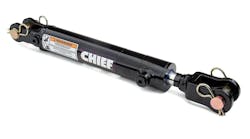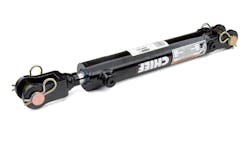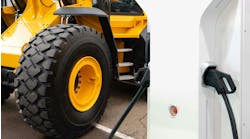Bailey International has developed the AT (Alternative to Tie Rod) hydraulic cylinders to be a drop-in replacement option for tie-rod cylinders.
Key features of the AT cylinders include:
- welded design for durability
- easy to use and repair as needed
- 3,000 psi pressure rating
- lack of bolts eases installation.
Welded Cylinder Design Provides Durability and Ease of Use
The AT hydraulic cylinders can be used any application where tie-rod cylinders are traditionally used such as agricultural and construction equipment. Their welded design provides a durable option capable of withstanding use in harsh operating environments. This design also overcomes some of the challenges associated with tie-rod hydraulic cylinders such as contamination and debris collection.
Matt Grussing, Director of Sales - Western USA at Bailey International, explained in an interview with Power & Motion that traditional tie-rod cylinders are comprised of two cast iron pieces held together with bolts, which can cause sticks or rocks to get caught between the parts and thus issues to occur. The welded design, however, eliminates this issue as the cylinder is essentially a single part and there are no areas in which objects can get stuck.
Instead of bolts, the AT cylinder simply requires removal of a screw-on gland and replacement of seals; it can then be dropped into the exact same space where the tie-rod cylinder used. This also makes replacement of the cylinder easy, helping to minimize downtime for machine owners.
The cylinder features steel casting welded clevis end mounts and hard chrome-plated rods which enable it to withstand use in a range of harsh environments. It also has a high-precision welded piston, further ensuring its durability.
Bailey has tested the AT hydraulic cylinders with a 6,000 psi burst pressure and 20,000-cycle endurance test to provide further assurance of the component's capabilities in various mobile equipment applications.
A Cylinder to Benefit Numerous Applications
Although initially developed for the agricultural equipment which Grussing said accounts for the highest percentage of tie-rod cylinder users, the AT hydraulic cylinder can be used in various other applications as well.
He said the cylinder is not designed for applications with high shock loads and heavy impacts, but instead those where something is being placed or positioned. "There's a lot of applications that would require something to be positioned [such as] if you're using a slip form paver for putting a curb in...sometimes it'll just have a positioning cylinder. This would be a great application for something where it's just a positioning kind of a thing," he explained.
Essentially, the AT hydraulic cylinder is suited for light- to medium-duty applications. Grussing said it could be a good option for those who would not consider a tie-rod cylinder but want a welded option as it offers a lower entry point as far as costs are considered. "And it will do the job for as long as any other product would do it out there, if not better," he said.



